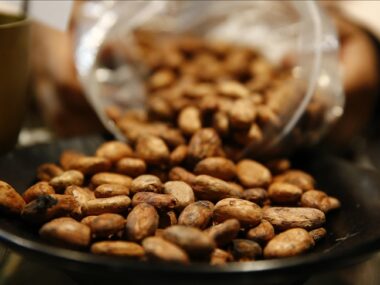
Burgundy, known as one of France’s most renowned wine regions, counts the U.S. as its top export destination. However, Donald Trump’s tariffs now risk making European wines too expensive for American consumers.
In the damp spring weather, vineyard worker Élodie Bonet is carefully removing extra vine shoots to help the plant concentrate its energy on grape-producing buds.
As she continues her work among the vines, winemaker Cécile Tremblay welcomes the visitor to her estate in Morey-Saint-Denis. In her cellar, surrounded by barrels and aged bottles bearing iconic names like Vosne-Romanée and Clos-Vougeot, she shares that more than half of her wine is sold internationally, with about 10% going to the U.S.—a significant share for her business.
Trump initially threatened a 200% duty on European alcohol, but on April 5, he set tariffs at 20% on nearly all EU goods. Just four days later, that was reduced to 10%, but with the warning that it could return to 20% by July based on trade talks. A possible 50% tariff looms in the future.
Asked if she’s concerned, Ms. Tremblay replies, “Yes, sure. As everybody is.” But she doesn’t elaborate further, reflecting the caution among French winemakers who are reluctant to speak out and risk worsening the situation.

Winemaker Cécile Tremblay admits Trump’s tariffs are a concern, though she hesitated to comment further.
Hoping for a clearer perspective, I drive to visit François Labet, a neighbour of Cécile Tremblay and president of the Burgundy Wine Board, which represents the region’s 3,500 winemakers.
He confirms the U.S. remains Burgundy’s most important export destination, leading both in volume and revenue. While French wine and spirit exports dipped by 4% globally last year, Burgundy’s exports to the U.S. climbed sharply—up 16% in volume to 20.9 million bottles and 26.2% in value, totaling €370 million.
Labet notes that the U.S. made up around 25% of Burgundy’s total wine exports last year.
Burgundy is famed for its red wines, made primarily from the pinot noir grape. Ironically, in English-speaking countries, “burgundy” is more often recognized as a color than a wine. The French refer to that color as “bordeaux”—a nod to their wine knowledge, as two-thirds of Burgundy’s production is actually white wine, largely from the chardonnay grape. Chablis, a standout white, is especially popular in the U.S.
The region also produces Crémant de Bourgogne, a sparkling wine growing in popularity, and small quantities of rosé. These shifts benefit Burgundy, as global red wine consumption declines while white and sparkling wines remain strong or are increasing.
Moreover, Labet believes Burgundy’s lighter red wines are becoming more desirable, contrasting with fuller-bodied reds often produced in the U.S. “There’s a clear trend away from heavy reds—those high in alcohol and aged in new wood,” he says.
Despite climate change, Burgundy’s cooler conditions result in grapes with lower sugar and alcohol levels—something modern wine consumers are increasingly seeking.

At the premium level, Burgundy is home to some of the most expensive wines in the world.
François Labet recalls that during Donald Trump’s first presidency, a 25% import tariff on European wines—imposed amid an airline-related trade dispute—had a severe impact. “We were hostages of that situation,” he says, noting that Burgundy’s wine exports to the U.S. dropped by roughly 50%.
With the current 10% tariff, Labet expects French producers and American importers will likely share the cost to keep sales going. However, he warns that if Trump raises tariffs to 20% in July, as threatened, it could bring exports to a near standstill—similar to the downturn in 2019.
The broader French wine industry may face even steeper consequences. Jérôme Bauer, head of the French National Wines and Spirits Confederation, highlights that the previous 25% tariff led to rapid losses of around $600 million. At that time, Champagne and wines with over 14% alcohol content were exempt—protection that may not apply now.
Bauer advocates for a free trade approach with no tariffs, a predictable stance given Europe’s trade surplus with the U.S. in wines and spirits.

US wineries have experienced a sharp decline in sales to Canada, as a boycott of American goods has brought trade to a near standstill.
Surprisingly, even American winemakers in regions like California and Oregon are alarmed by the tariffs. Rather than celebrating the pressure on European rivals, they’re voicing concern.
“This looks horrible from our perspective. We don’t like it one bit,” says Rex Stoltz, vice-president of industry relations at Napa Valley Vintners, which represents 540 wineries in California’s premier wine region.
Stoltz explains that wine production is globally interconnected—even in Napa, corks come from Portugal and oak barrels from France. He notes these materials are already costly, and tariffs risk making them even pricier.
He also points out the consequences of retaliatory trade measures. Canadian tariffs, for instance, have severely disrupted U.S. wine exports. “Canada is the most important export market for California wines, and among the top for Napa Valley,” Stoltz says. “Right now, there are zero Napa Valley wines on Canadian store shelves—they’ve removed all American alcoholic beverages.”
Stoltz concludes with a plea: “We just want to compete on a level playing field with our friends and neighbours around the world. That’s what we hope for.”










